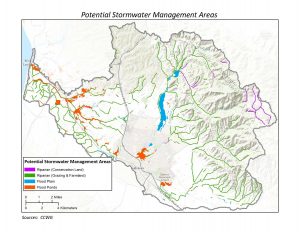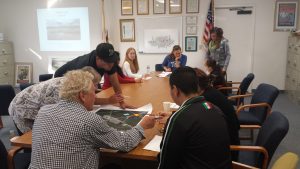Regional Planning
The Lower Gabilan Watershed has been a focus area for staff at CCWG for well over a decade. This area encompasses a large range of landuse including: urban development in Salinas and Castroville; agriculture, particularly intensive row crops such as strawberries and leafy greens; natural wetlands and open space, which used to dominate the landscape but are now found only in fragments. This area is also home to some of the most polluted waterbodies in the state. Tembladero Slough, for example, is listed for 14 TMDL pollutants. We see a lot of potential for improving water quality, adding valuable habitat for wildlife, and providing community access to open space. This can be done without compromising the productivity of the region or the safety of the food grown here. For more information on how we are addressing improved coordination and the implementation of projects in the lower Gabilan, please see our projects.
Lower Salinas Valley Multi-Benefit Land Repurposing Strategy and Phase 1 Project Development, 2022-2026, DOC
The proposed project will build on the work of the Watershed Coordinators by providing the funds for willing agricultural landowners and growers to lead, with project partners, an effort that assesses the benefits and constraints for repurposing agricultural land to uses consistent with the Irrigated Lands Regulatory Program, Sustainable Groundwater Management Act, and local plans and policies, and begin implementation (land acquisition, planning, and design) of projects prioritized from this effort.
The repurposing goals and objectives will build on the goals and project concepts that have been evaluated, compiled and integrated within three key planning documents: 2018 Greater Monterey County IRWM Plan, 2019 Greater Monterey County Storm Water Resource Plan, and 2020/2022 Salinas Groundwater Sustainability Plans. Through the guidance of these documents, the Watershed Coordinators have successfully worked with four key partners – Central Coast Wetlands Group (CCWG), City of Salinas, Salinas Valley Basin GSA, and the Greater Monterey County IRWM Regional Water Management Group – to develop multi-benefit water resource management objectives that benefit water resources and the agricultural community. Landowners and growers will work with the Watershed Coordinators and project partners to co-define repurposing locations and potential benefits including flood risk reduction and attenuation, direct and in-lieu recharge, water conservation, and water quality improvement.
A Collaborative Approach to Groundwater Sustainability in Southern Monterey Bay Watersheds, 2021-2024; DOC
This Watershed Coordinator effort will address key gaps in agency capacity and will specifically (1) increase coordination and collaboration between the Greater Monterey County Regional Water Management Group (RWMG) and the SVBGSA, and (2) coordinate the implementation of multi-stakeholder projects prioritized within the Greater Monterey County IRWM Plan, Storm Water Resources Plan, and Salinas Valley Basin GSP. The Watershed Coordinators will work with GSA staff, RWMG members, agricultural entities, water and natural resource decision makers, and disadvantaged communities to facilitate the development of local watershed and groundwater sustainability efforts (groundwater recharge, flood management, and creek restoration). The Watershed Coordinators will identify specific project opportunity sites within the watershed that address the goals of above-listed plans that are beyond the scope of our agency and municipal partners.
Link to Final Report

Storm Water Resource Plan for the Greater Monterey County IRWMP
The project will create a new, watershed-based SWRP for the Greater Monterey County IRWM Region that will meet all requirements of Water Code §10560 et seq. and SWRP Guidelines. The lead applicant is Coastal Conservation and Research, Inc. a nonprofit organization. The plan will be developed on behalf of the Monterey County Resource Management Agency, which administers the Phase II NPDES permit for unincorporated urbanized areas. Watershed boundaries include the Salinas River (within Monterey County, 2,490 sq mi) and Alisal-Elkhorn Sloughs watersheds (232 sq mi). The project will include metrics-based quantitative analyses of hydrologic, topographic, and environmental conditions and opportunities, which will provide a framework for identifying and evaluating implementation projects to include in the SWRP. The resulting SWRP will describe and prioritize multi-benefit implementation projects to achieve water supply, water quality, flood control, environment, and community objectives.

Castroville Community Outreach
The Castroville community is located approximately eight miles northwest of Salinas and five miles west of Prunedale in North Monterey County. The surrounding area is dominated by a system of sloughs that receive drainage from large, primarily agricultural, watershed areas and ultimately flow to Monterey Bay. The Elkhorn and Moro Cojo Sloughs, still in a moderately natural condition, are located to the north of Castroville. Smaller sloughs that have been channelized over time to accommodate agricultural runoff include the Tembladero Slough, located just southwest of downtown Castroville, and the Castroville Slough located northeast of the community. Both are extremely degraded with limited habitat values and high levels of contaminates. There is also minimal park land, limited recreational space (such as soccer fields), and very limited access to nature and even through parts of town via trails a person can use without a car.The location of the community of Castroville in the vicinity of the existing slough systems offers an excellent opportunity to undertake enhancement activities in conjunction with the new development and redevelopment projects described in the Community Plan, as well as locating additional project supported by the community. Enhancement of these resources will not only increase habitat value, but also provide the opportunity to create an integrated system of flood protection, drainage and water quality improvements, open space and recreation facilities, and strong visual features for the community.CCWG and partners such as the RCD of Santa Cruz have been holding a series of meetings to identify community supported projects to focus future efforts and direct future funding. These meetings are with agency staff, school representatives and the general community. Once projects have been identified that meet the goals of the community, CCWG can work to get approval for these projects and begin searching for various funding sources.

Greater Monterey County IRWMP
CCWG has played an active role in the development, drafting and implementation of the Greater Monterey County IRWMP. This includes taking part in all Regional Water Management Group meetings, drafting chapters of the Plan, and implementing projects.
Integrated regional water management (IRWM) is an approach to water management that is being strongly promoted by State water managers and legislators as a way to increase regional self-sufficiency. IRWM encourages local water resource managers to take a proactive, leadership role in solving water management problems on a local level through collaborative regional planning. This regional approach is considered necessary in order for water managers to be able to cope with the impending water management challenges ahead.
One important effort that CCWG has coordinated is the Water Resource Project Coordination (WRPC) process. The WRPC process represents an innovative approach through the Integrated Regional Water Management Plan (IRWMP) aimed at addressing and resolving water-related conflicts in the region, while promoting stakeholder collaboration and project integration. The goal of the WRPC process was to alleviate areas of mistrust and confusion and increase collaborative dialogue so that mutual solutions could be achieved.
The Gabilan Watershed was selected as the focus area for this pilot project, as a majority of Monterey County projects were proposed there. A series of facilitated stakeholder meetings followed. A decision was made to focus on identifying “shared values” in the Gabilan Watershed rather than moving directly to trying to find solutions to areas of disagreement. The stakeholder meeting in January 2013 began with the participants anonymously sharing their understanding of the challenges facing the region. In this way the “elephants in the room” were brought out into the open without individuals needing to self-identify as proponents or opponents. Then participants were divided into “affinity groups,” including agriculture, research, conservation, and government. Each group was asked to discuss amongst themselves their priorities for the watershed. Each participant was asked to create a visual image of their “desired future” for the watershed, its characteristics, and what they saw to be the key obstacles and opportunities for success. Finally, the discussion was turned to solutions. From the groups’ images and discussion, it became clear that there was actually more common ground amongst stakeholders than anticipated.
Based on the outcomes of the January 2013 stakeholder meeting, the WRPC Committee determined that the challenges to “making progress” in the Gabilan Watershed had less to do with a lack of information (e.g., scientific data) and more to do with funding constraints and other barriers. The challenges spanned such a large range of topics that the Committee felt a comprehensive “umbrella” was needed to pull it all together. That umbrella is what they termed the “Gabilan Watershed Blueprint.” The Gabilan Watershed Blueprint was envisioned as a process to address some of the major hurdles that have slowed and prevented progress in resolving problems related to water quality, and to a lesser extent flooding, in the Gabilan Watershed. The Gabilan Watershed Blueprint has four main “sections,” designed to address some of the regional challenges and opportunities expressed during the January 2013 stakeholder meeting. The final Blueprint document is available on the IRWMP website. The four Blueprint sections are 1) The Landscape Strategy, 2) On-Farm Solutions, 3) Corporate Social Responsibility, and 4) Agency Coordination

